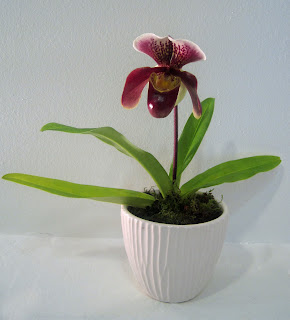Paphiopedilum, or slipper orchids, originate from the jungles of the Far
East and Indonesia. They are semi-terrestrial, growing in humus and
other material on the forest floor, on cliffs in pockets and
occasionally in trees.
LIGHT
Most Paphiopedilum prefer shady conditions. In the home, east, shaded south and east windows are ideal.
TEMPERATURE
Temperatures of the Paphiopedilum vary considerably, but most are separated by the warm growing mottled leaf group and the cool growing green leaf types. Warm types prefer 60-65F at night and 75-80F or more during in the day, cool types prefer 50-60F at night and 75-80Fduring the day. Although higher temperatures force faster vegetative growth, higher humidity and air movement must accompany higher temperatures, the recommended maximum being 100F
WATER
Water must be available to the roots constantly, since they have no pseudbulbs, and therefore store most of their water in their leaves. They need a moist medium – never soggy, but never dry either. Water once or twice a week and water only in the morning so the leaves are dry by nightfall to avoid rot from occurring on the leaves.
HUMIDITY
Paphiopedilum require humidity between 40-50%. In the home, set the plants on trays of gravel, partially filled with water so that the pot never sits in water or have a humidifier in the room. Mist the plant in dry climates or during dry weather in the morning only.
FERTILIZER
Use a fertilizer high in nitrogen (grow fertilizer) from about March to September and a fertilizer high in phosphorus (bloom fertilizer) the rest of the year. When in active growth plants need fertilizer every 2 weeks and when not growing, once a month. Thorough flushing with clear water every month is recommended to prevent build-up of fertilizer salts.
POTTING
This is best done in the Spring after blooming. Potting is usually done every 1 – 3 years. Mature plants can grow in the same pot until the potting medium starts to decompose, usually in 2 years. Root rot occurs if plants are left in a soggy medium. A fine grade potting medium is usually used for fine rooted plants and coarser mixes with large rooted plants. To re-pot, remove the entire old medium from the roots, trim soft/rotted roots and spread the remaining roots over a handful of medium in the bottom if a new pot. Fill the rest of the pot with medium, working it through the roots, so that the junction of the roots and the stem is buried ½” in the center of the pot. Keep plant shaded and humid, but drier in the pot, for several weeks, to promote new root growth. Do not over pot the average plant should have a 4-6” pot.
Blog created by Modern Petals - Your local Calgary Florist. We specialize in unique and creative everyday and wedding floral design. Check out our site at www.modernpetals.com.
LIGHT
Most Paphiopedilum prefer shady conditions. In the home, east, shaded south and east windows are ideal.
TEMPERATURE
Temperatures of the Paphiopedilum vary considerably, but most are separated by the warm growing mottled leaf group and the cool growing green leaf types. Warm types prefer 60-65F at night and 75-80F or more during in the day, cool types prefer 50-60F at night and 75-80Fduring the day. Although higher temperatures force faster vegetative growth, higher humidity and air movement must accompany higher temperatures, the recommended maximum being 100F
WATER
Water must be available to the roots constantly, since they have no pseudbulbs, and therefore store most of their water in their leaves. They need a moist medium – never soggy, but never dry either. Water once or twice a week and water only in the morning so the leaves are dry by nightfall to avoid rot from occurring on the leaves.
HUMIDITY
Paphiopedilum require humidity between 40-50%. In the home, set the plants on trays of gravel, partially filled with water so that the pot never sits in water or have a humidifier in the room. Mist the plant in dry climates or during dry weather in the morning only.
FERTILIZER
Use a fertilizer high in nitrogen (grow fertilizer) from about March to September and a fertilizer high in phosphorus (bloom fertilizer) the rest of the year. When in active growth plants need fertilizer every 2 weeks and when not growing, once a month. Thorough flushing with clear water every month is recommended to prevent build-up of fertilizer salts.
POTTING
This is best done in the Spring after blooming. Potting is usually done every 1 – 3 years. Mature plants can grow in the same pot until the potting medium starts to decompose, usually in 2 years. Root rot occurs if plants are left in a soggy medium. A fine grade potting medium is usually used for fine rooted plants and coarser mixes with large rooted plants. To re-pot, remove the entire old medium from the roots, trim soft/rotted roots and spread the remaining roots over a handful of medium in the bottom if a new pot. Fill the rest of the pot with medium, working it through the roots, so that the junction of the roots and the stem is buried ½” in the center of the pot. Keep plant shaded and humid, but drier in the pot, for several weeks, to promote new root growth. Do not over pot the average plant should have a 4-6” pot.
Blog created by Modern Petals - Your local Calgary Florist. We specialize in unique and creative everyday and wedding floral design. Check out our site at www.modernpetals.com.

No comments:
Post a Comment